Birds in Zaire are a diverse and vibrant part of the country’s wildlife. Zaire is home to over 700 birds, including some of the most spectacular species in the world.
From the colorful and showy African parrots to the more secretive and elusive waterfowl, Zaire is a paradise for birdwatchers and nature enthusiasts alike.
The lush forests, wetlands, and savannahs provide a perfect habitat for various bird species, and the variety of bird life in Zaire is genuinely awe-inspiring. Whether you are looking for a rare species or want to see some beautiful birds, Zaire is the place to go.
13 Birds to Watch in Zaire
Zaire, also known as the Democratic Republic of the Congo, is rich in biodiversity and home to many fascinating bird species, whether you are a birdwatcher, a nature lover, or just curious.
Here are 13 birds to watch in Zaire that will amaze you with their colors, shapes, and behaviors.
1. Black-winged Stilt
The black-winged stilt is a long-legged bird from the avocet and stilt family. It is a widespread species found in various parts of the world. Scientifically, it is known as H.
Himantopusis is considered a single species instead of being divided into multiple species. It is a wading bird, meaning it spends most of its time wandering around shallow bodies of water looking for food.
Its long legs help it move through the water without sinking too much. It also has black wings, called a ‘black-winged stilt.’ The black-winged stilt is a social bird, often found in large flocks and breeding colonies.
It feeds mainly on small aquatic creatures such as mollusks, crustaceans, and insects. It also eats small fish and some plants. Breeding usually occurs between April and August.
The female lays two to four eggs, which the male and female incubate. The black-winged stilt is an essential species due to its wide distribution.
It serves as an essential link in the food chain, providing food for other species and helping maintain the ecosystem’s balance.
| Kingdom | Animalia |
| Phylum | Chordata |
| Class | Aves |
| Order | Charadriiformes |
| Family | Recurvirostridae |
| Genus | Himantopus |
| Species | H. himantopus |
2. Bar-tailed Godwit
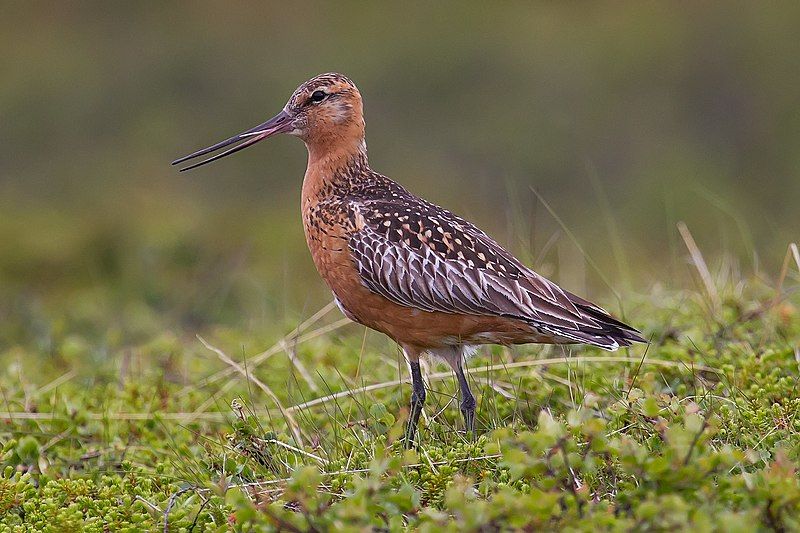
The bar-tailed godwit is a majestic bird that belongs to the Scolopacidae family of waders. Its most striking feature is its distinct red breeding plumage, showing its beautiful colors. Its long legs and upturned bill make it easy to distinguish from other species.
It is a strongly migratory bird that feeds on various bristle worms and shellfish found in coastal mudflats and estuaries. The bar-tailed godwit is a fantastic bird with a fascinating life cycle.
Every year, the godwit will migrate thousands of miles from its breeding grounds in the northern hemisphere to its wintering grounds in the southern hemisphere. During these journeys, they will face numerous dangers, such as storms, predators, and exhaustion.
To survive such a long journey, the godwit must have a strong will and determination. The bar-tailed godwit is an important species to many coastal ecosystems. Its long bill helps it pluck out the bristle worms and shellfish it feeds on from the mudflats.
This helps to keep the mudflats clean and free from pests. In addition, the godwit’s droppings also provide a rich source of nutrients for other species that inhabit the mudflats. The bar-tailed godwit is an extraordinary bird that is essential to its environment.
Its long legs, striking red plumage, and long upturned bill make it stand out. Its strength and determination during its long migrations make it a symbol of hope and resilience. It is a species that deserves our respect and admiration.
| Kingdom | Animalia |
| Phylum | Chordata |
| Class | Aves |
| Order | Charadriiformes |
| Family | Scolopacidae |
| Genus | Limosa |
| Species | L. lapponica |
3. Glossy Ibis
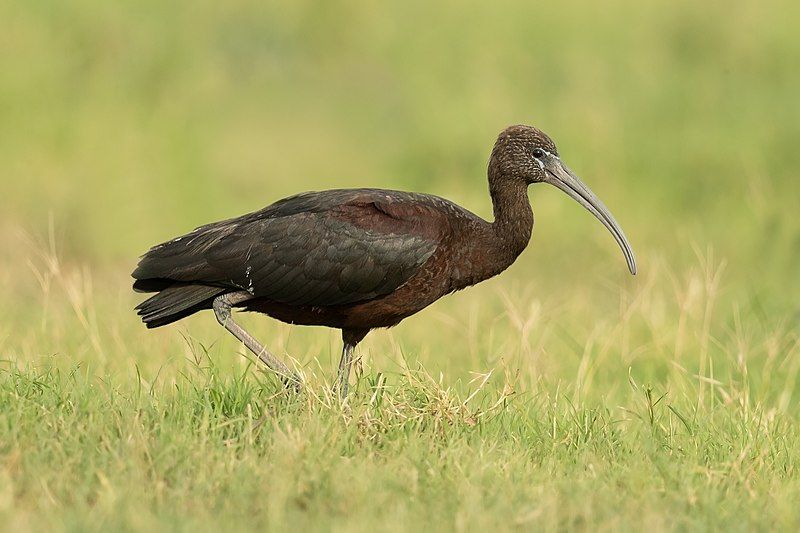
The glossy ibis is a water bird that belongs to the order Pelecaniformes and the ibis and spoonbill family Threskiornithidae.
This species of bird has a unique and distinctive bill shape, which is why its scientific name is derived from the Ancient Greek word “pleads” and the Latin word “facts,” both meaning “sickle.”
The bird’s bill is curved and long; it has a similar shape to that of a sickle and is quite prominent. The glossy ibis is a distinct bird and easily identifiable due to its unique bill shape.
Its bill is the most essential feature that distinguishes it from other birds. This bird species is found in many parts of the world, such as Asia, Africa, Europe, and North America. It is usually found near wetlands, marshes, and estuaries.
The glossy ibis has a dark plumage, long legs, and a long neck. This bird species is often seen in large flocks and can be very vocal. It feeds on various small aquatic animals and insects, which it catches with its sharp bill.
The glossy ibis is an essential species in the ecosystem, as it helps to control insect populations and can also serve as an effective indicator of environmental health.
| Kingdom | Animalia |
| Phylum | Chordata |
| Class | Aves |
| Order | Pelecaniformes |
| Family | Threskiornithidae |
| Genus | Plegadis |
| Species | P. falcinellus |
4. Hooded Vulture
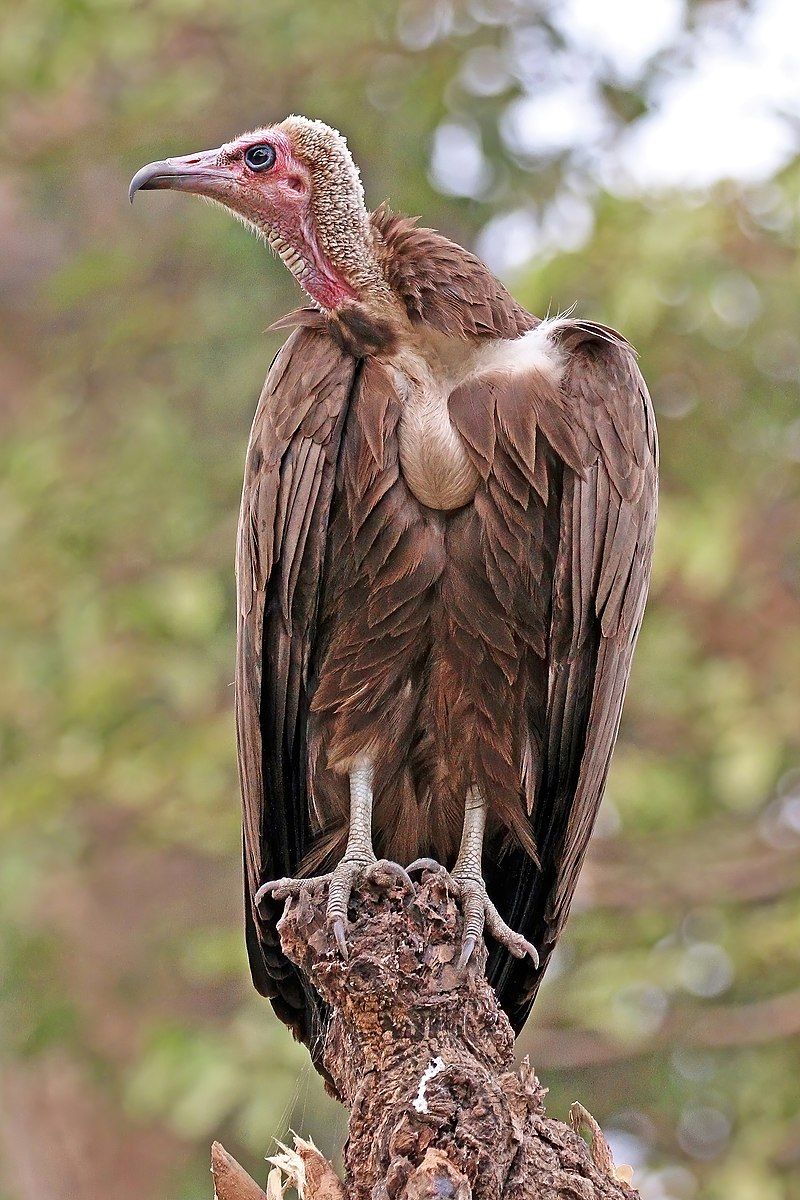
The hooded vulture is an Old World vulture belonging to the order Accipitriformes, which also includes many other birds of prey, such as eagles, kites, vultures, and hawks. It is the only member of the genus Necrosyrtes, which is closely related to the larger Gyps genus.
These genera are a part of the Aegypiinae subfamily of Old World vultures. The hooded vulture is a distinctive bird, with its black hooded feathers and pale grey body.
It is generally found in the drier parts of Africa, although it has been known to migrate to other parts of the world.
It feeds mainly on carrion and takes small animals such as rodents, small reptiles, and even insects. The hooded vulture can live in various habitats, ranging from dry savannas to open woodlands and forests.
It prefers to roost and nest in tall trees and rocky outcrops.
It is an opportunistic feeder and will take advantage of any available food source, including carrion, insects, and small animals. The hooded vulture is an integral part of the African ecosystem, helping to keep the environment clean by feeding on dead animals.
It is also an efficient scavenger and can help control the population of rodents and other animal species. Its nesting sites provide shelter to other animals, and its presence can help to maintain ecological balance in its environment.
| Kingdom | Animalia |
| Phylum | Chordata |
| Class | Aves |
| Order | Accipitriformes |
| Family | Accipitridae |
| Genus | Necrosyrtes |
| Species | N. monachus |
5. Marabou Stork
The marabou stork is a large wading bird found in sub-Saharan Africa. It is part of the Ciconiidae family, which comprises many species of storks. This unique bird species is known to inhabit wet and dry habitats and can often be seen near human settlements.
This includes areas such as landfill sites, where they scavenge for food. The marabou stork is often seen wading through shallow waters or wetlands for food.
Its diet consists mainly of aquatic animals and carrion, although it will also feed on insects, small mammals, and eggs.
The stork is adapted to its environment, with long legs and an enormous wingspan that allows it to move quickly through shallow water. The marabou stork is a social bird and often forms large flocks.
It is also an opportunistic species, taking advantage of available resources.
This is why the stork is often found near human settlements, as it can take advantage of the resources provided. The marabou stork is an essential species in its native range, as it helps control aquatic animal populations and carrion.
It is also an essential source of food for humans in some areas. In addition, the large stork is an iconic species in the region, and its presence is often seen as a sign of luck and good fortune.
| Kingdom | Animalia |
| Phylum | Chordata |
| Class | Aves |
| Order | Ciconiiformes |
| Family | Ciconiidae |
| Genus | Leptoptilos |
| Species | L. crumenifer |
6. African Sacred Ibis
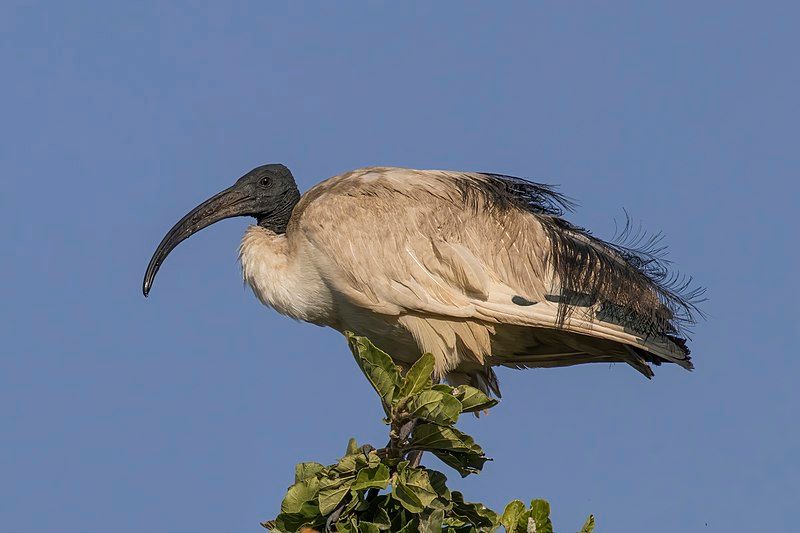
The African sacred ibis is a species of ibis, a large wading bird that belongs to the family Threskiornithidae. This bird is found throughout much of Africa and in small parts of Iraq, Iran, and Kuwait.
It is a species that has been revered throughout history, particularly in Ancient Egypt, where it was closely associated with the god Thoth. This particular species of ibis was known to symbolize wisdom and learning and was often depicted in hieroglyphs.
It was believed that the ibis could communicate with the gods and was viewed as a messenger between the heavens and the people. As a result, it was treated with the utmost respect and even mummified after death.
The African sacred ibis is an integral part of the history and culture of many cultures, with its significance spanning thousands of years.
| Kingdom | Animalia |
| Phylum | Chordata |
| Class | Aves |
| Order | Pelecaniformes |
| Family | Threskiornithidae |
| Genus | Threskiornis |
| Species | T. aethiopicus |
7. Buttonquail
Buttonquail, also known as hemipodes, are small birds belonging to the Turnicidae family. They are not closely related to the quails of the family Phasianidae, although they do have a similar appearance.
Buttonquail inhabits warm grasslands in various parts of the world, including Asia, Africa, Europe, and Australia. They prefer areas with open grasslands, and their diet consists mainly of insects, seeds, and other small plant material.
Buttonquail are solitary birds and live in small family groups. They are ground-dwelling and have short wings, allowing them to dash to escape predators. Buttonquail are also good at camouflage due to their mottled brown and black coloration.
They will freeze when disturbed, which helps them blend into their environment. Buttonquail are monogamous and pair for life. Females lay eggs in a shallow nest, usually found in thick vegetation.
Males take care of the eggs and chicks and are the primary guardians of the nest. Buttonquail is a unique and fascinating bird species found in several parts of the world.
| Kingdom | Animalia |
| Phylum | Chordata |
| Class | Aves |
| Order | Charadriiformes |
| Family | Turnicidae |
8. Crowned Eagle
The crowned Eagle is a large, majestic bird of prey found in the sub-Saharan region of Africa. It is also known as the African crowned Eagle or the crowned hawk-eagle and is usually found in the eastern part of Southern Africa.
Its preferred habitat is mainly riparian woodlands, land areas near water, and various types of forests.
Given its size and hunting capabilities, it plays a vital role as a top predator in its environment. The crowned Eagle has distinctive features that make it easy to identify. It has a chestnut brown body, a whitish underside, and a white head with a unique black crest.
It also has a large, hooked beak perfect for tearing apart its prey.
Its wingspan is usually between five and six feet, weighing up to five pounds. The crowned Eagle is an opportunistic hunter who will take advantage of whatever prey is available. Its diet consists of small mammals, reptiles, and even smaller birds.
It typically hunts by swooping down from a high perch and grabbing its prey with its talons. The crowned Eagle is also an essential part of the environment, as it helps keep its prey populations balanced.
It symbolizes power and strength and is a popular subject in African art and folklore.
| Kingdom | Animalia |
| Phylum | Chordata |
| Class | Aves |
| Order | Accipitriformes |
| Family | Accipitridae |
| Genus | Stephanoaetus |
| Species | S. coronatus |
9. Denham’s Bustard
Denham’s bustard, also known as Stanley’s bustard, is a large bird species in the bustard family. It is native to much of Sub-Saharan Africa and can be found in various habitats, such as open agricultural land, grasslands, floodplains, and even burnt fynbos.
It is a non-migratory species that remains in its native area year-round. However, some inland populations may migrate to lower altitudes in winter, presumably to look for more favorable conditions. These birds are omnivorous, eating both plant and animal matter.
They have a wide range of vocalizations, though they are usually quiet. They are generally solitary but may gather in small groups in winter.
Denham’s bustard is an essential species in its native range, providing food for other animals, such as predators and scavengers.
| Kingdom | Animalia |
| Phylum | Chordata |
| Class | Aves |
| Order | Otidiformes |
| Family | Otididae |
| Genus | Neotis |
| Species | N. denhami |
10. Greater Flamingo
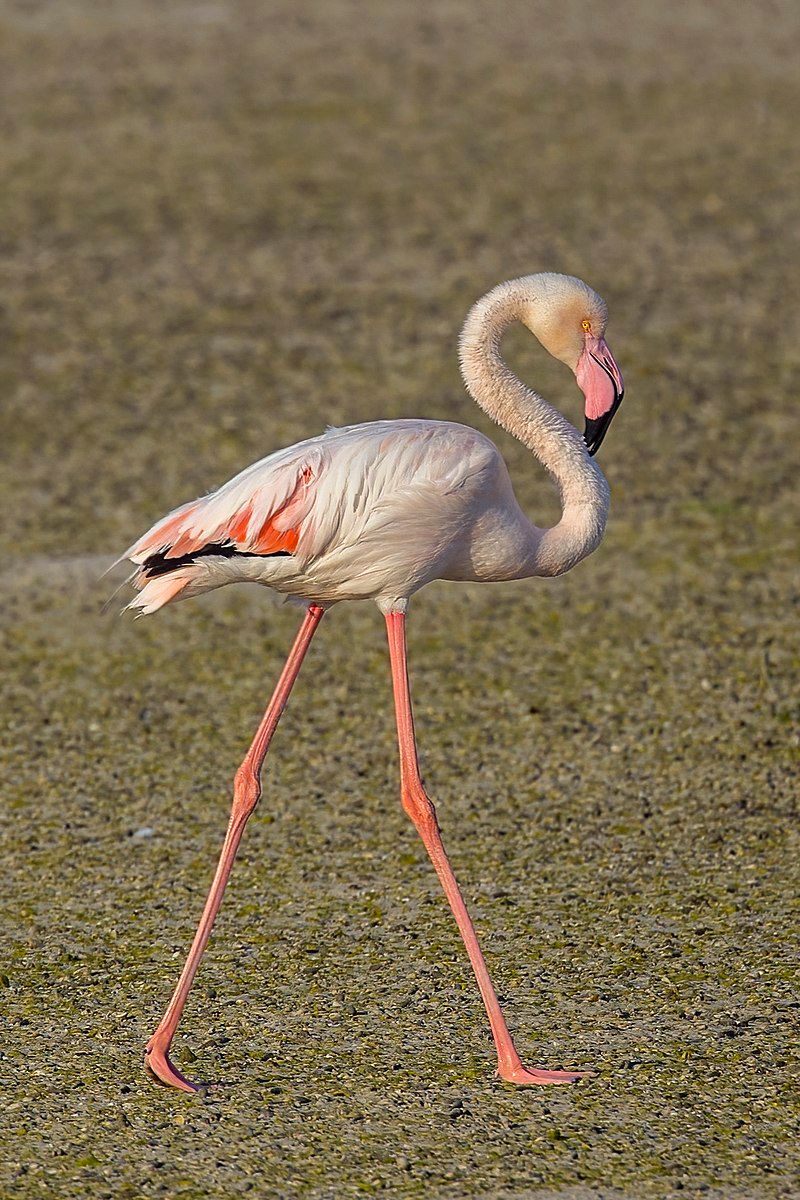
The greater flamingo is a species found in many parts of the world. It is the most significant and most widespread species of the flamingo family.
These birds are commonly found in Northern and Sub-Saharan Africa, the Indian Subcontinent, the Middle East, the Levant, the Persian Gulf, the Gulf of Aden, the Red Sea, and the Mediterranean countries of Southern Europe.
The greater flamingo is a distinctive bird with a long neck, long legs, and pinkish-white feathers. Its wingspan can reach up to 1.5 m (nearly 5 ft), and the bird can weigh up to 3.5 kg (7.7 lbs).
They have a unique diet, consisting primarily of small crustaceans, mollusks, and other invertebrates. The greater flamingo is a social species living in large colonies that can number thousands. They often gather in shallow lakes and lagoons to feed and breed.
During the breeding season, they build large mud nests, laying a single egg at a time. Both parents are responsible for incubating the egg and caring for the hatchling. The greater flamingo is an iconic species, with its bright pink feathers and long, elegant neck.
It is an integral part of the ecosystems in which it lives, helping to keep it healthy and balanced. This species is currently listed as Least Concern by the IUCN, though their population numbers are decreasing in some areas due to human activity.
| Kingdom | Animalia |
| Phylum | Chordata |
| Class | Aves |
| Order | Phoenicopteriformes |
| Family | Phoenicopteridae |
| Genus | Phoenicopterus |
| Species | P. roseus |
11. Kori Bustard
The kori bustard is a large bird native to Africa and is part of the bustard family. Bustards, found exclusively in the Old World, belong to Otidiformes. The kori bustard is one of four species in the large-bodied genus Ardeotis.
This bird is the largest of all the flying birds in Africa, easily recognizable by its unique size and colors. Its feathers are black and white, with a distinctive white throat and black belly.
The kori bustard can be found in various habitats, including grasslands, savannas, and open country. It is an omnivorous bird, which means it eats a wide range of foods, including insects, small mammals, and reptiles.
The kori bustard can also be seen near water, where it will feed on aquatic animals such as frogs and fish. The kori bustard is a territorial bird and will vigorously defend its home from intruders.
The female kori bustard typically lays two to five eggs each season, which she incubates for around 28 days before they hatch. The kori bustard is an integral part of African ecology and an iconic species for conservationists.
| Kingdom | Animalia |
| Phylum | Chordata |
| Class | Aves |
| Order | Otidiformes |
| Family | Otididae |
| Genus | Ardeotis |
| Species | A. kori |
12. Lappet-faced Vulture
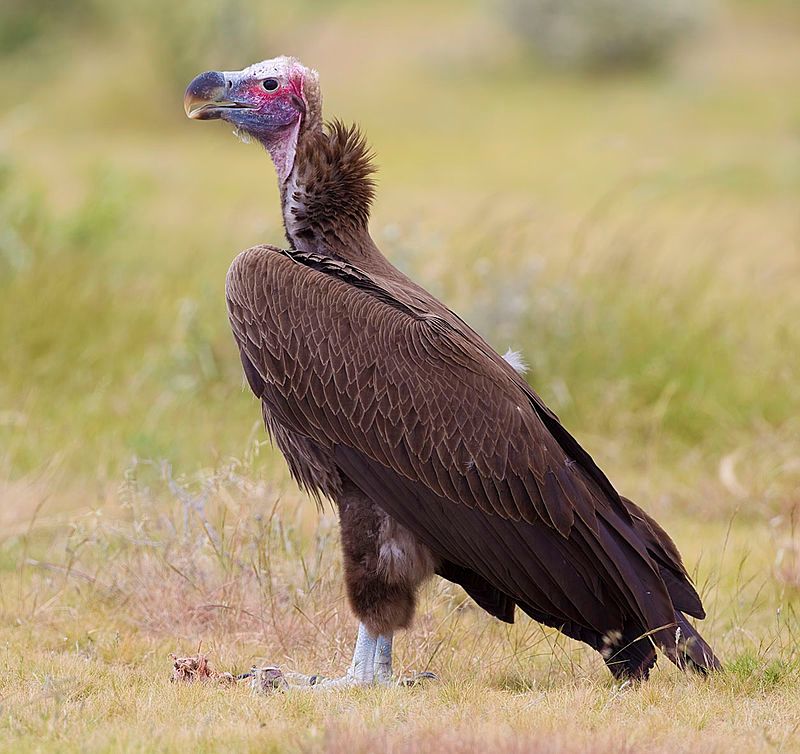
The lappet-faced vulture, known as the Nubian vulture, is an Old World species native to Africa.
It is the only member of the genus Torgos and belongs to the bird order Accipitriformes, which includes other large birds of prey such as eagles, kites, vultures, and hawks.
The lappet-faced vulture has a striking appearance: a bald head, a long neck, and a distinctive tuft of feathers on its forehead. It has a wingspan of up to 8 feet, making it one of the world’s most giant birds of prey.
Its diet typically consists of carrion, although it will also feed on eggs, small birds, and mammals. Its habitat is mainly open savanna and grasslands, where it can be found soaring gracefully above the ground in search of food.
The lappet-faced vulture is an integral part of the ecosystem, as it helps to control the population of small animals, such as rodents, by consuming their carcasses.
Unfortunately, the species is threatened by habitat loss and illegal hunting, and its population is declining.
Therefore, conservation efforts are needed to ensure this species can continue thriving in its natural habitat.
| Kingdom | Animalia |
| Phylum | Chordata |
| Class | Aves |
| Order | Accipitriformes |
| Family | Accipitridae |
| Genus | Torgos |
| Species | T. tracheliotos |
13. Egyptian Goose
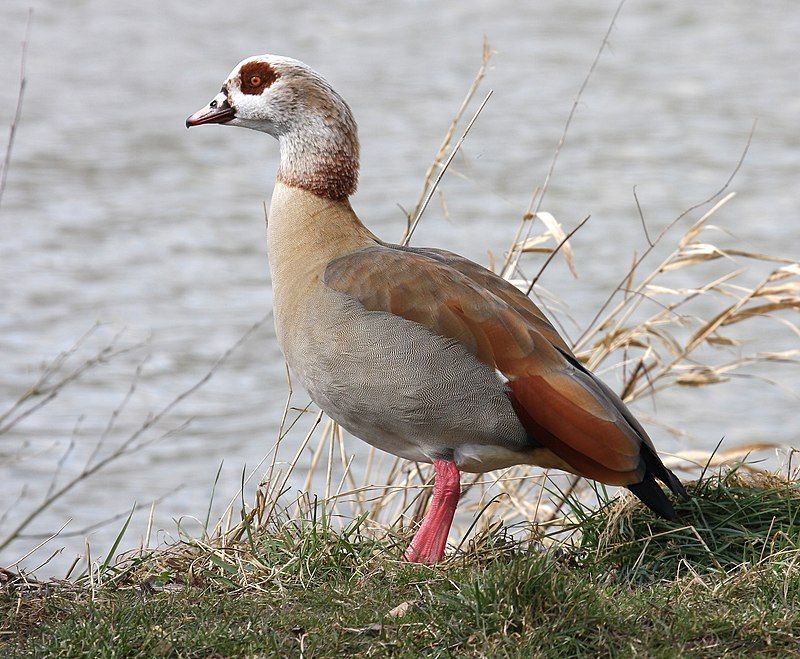
The Egyptian goose is a native species of Africa that falls under the Anatidae family, commonly called the duck family.
This bird has become increasingly popular due to its aesthetically pleasing features and has been introduced to countries outside of its natural range, such as Europe and the United States.
This introduction can be attributed to its popularity as an ornamental bird, with people hoping to bring a bit of Africa to their gardens. Introducing these birds has also benefited their natural range, as they are now found in many other parts of the world.
The Egyptian goose is a beautiful bird with distinctive black and white plumage, a long neck, and a striking orange bill. It is a social species, often found in flocks alongside other waterfowl.
The species has adapted to many climates and can be found in wet and dry habitats. In its natural range, the Egyptian goose feeds on vegetation, insects, small fish, and other aquatic invertebrates.
They also use their long neck to reach higher vegetation, such as reeds and grasses. The introduction of the Egyptian goose to other parts of the world has allowed this species to expand its range, and it is now a common sight in many regions.
| Kingdom | Animalia |
| Phylum | Chordata |
| Class | Aves |
| Order | Anseriformes |
| Family | Anatidae |
| Genus | Alopochen |
| Species | A. aegyptiaca |
Conclusion
Birds in Zaire are essential to the country’s biodiversity, offering various unique species and crucial to the region’s ecosystems.
The diversity of bird species in Zaire is a testament to the abundance of natural resources and a reminder of the importance of preserving and protecting the environment.
The presence of birds in Zaire reminds us of nature’s beauty and the value of protecting and preserving it for future generations.